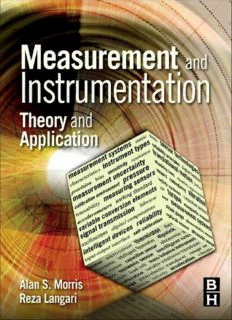
Measurement and Instrumentation - Theory and Application – Elsevier Academic Press PDF
Preview Measurement and Instrumentation - Theory and Application – Elsevier Academic Press
Measurement and Instrumentation This page intentionally left blank Measurement and Instrumentation Theory and Application Alan S. Morris Reza Langari AMSTERDAM (cid:129) BOSTON (cid:129) HEIDELBERG (cid:129) LONDON NEW YORK (cid:129) OXFORD (cid:129) PARIS (cid:129) SAN DIEGO SAN FRANCISCO (cid:129) SINGAPORE (cid:129) SYDNEY (cid:129) TOKYO Academic Press is an imprint of Elsevier AcademicPressisanimprintofElsevier 225WymanStreet,Waltham,MA02451,USA 525BStreet,Suite1800,SanDiego,California92101-4495,USA 84Theobald’sRoad,LondonWC1X8RR,UK #2012ElsevierInc.Allrightsreserved. Nopartofthispublicationmaybereproducedortransmittedinanyformorbyanymeans, electronicormechanical,includingphotocopying,recording,oranyinformationstorage andretrievalsystem,withoutpermissioninwritingfromthepublisher.Detailsonhowto seekpermission,furtherinformationaboutthePublisher’spermissionspoliciesandour arrangementswithorganizationssuchastheCopyrightClearanceCenterandtheCopyright LicensingAgency,canbefoundatourwebsite:www.elsevier.com/permissions. Thisbookandtheindividualcontributionscontainedinitareprotectedundercopyrightbythe Publisher(otherthanasmaybenotedherein). Notices Knowledgeandbestpracticeinthisfieldareconstantlychanging.Asnewresearchand experiencebroadenourunderstanding,changesinresearchmethods,professionalpractices, ormedicaltreatmentmaybecomenecessary. Practitionersandresearchersmustalwaysrelyontheirownexperienceandknowledgeinevaluating andusinganyinformation,methods,compounds,orexperimentsdescribedherein.Inusingsuch informationormethodstheyshouldbemindfuloftheirownsafetyandthesafetyofothers,including partiesforwhomtheyhaveaprofessionalresponsibility. Tothefullestextentofthelaw,neitherthePublishernortheauthors,contributors,oreditors,assume anyliabilityforanyinjuryand/ordamagetopersonsorpropertyasamatterofproductsliability, negligenceorotherwise,orfromanyuseoroperationofanymethods,products,instructions,orideas containedinthematerialherein. LibraryofCongressCataloging-in-PublicationData Morris,AlanS.,1948- Measurementandinstrumentation:theoryandapplication/AlanS.Morris;RezaLangari, contributor. p.cm. ISBN978-0-12-381960-4(pbk.) 1.Measurement.2.Automaticcontrol.3.Engineeringinstrument.I.Langari,Reza.II.Title. T50.M6442011 681–dc23 2011018587 BritishLibraryCataloguing-in-PublicationData AcataloguerecordforthisbookisavailablefromtheBritishLibrary. ISBN:978-0-12-381960-4 ForinformationonallAcademicPresspublications visitourWebsiteatwww.elsevierdirect.com PrintedintheUnitedStatesofAmerica 11 12 13 14 9 8 7 6 5 4 3 2 1 Contents Acknowledgement...........................................................................................xvii Preface...........................................................................................................xix Chapter 1 Fundamentals of Measurement Systems...............................................1 1.1 Introduction............................................................................................................1 1.2 Measurement Units................................................................................................2 1.3 Measurement System Design................................................................................3 1.3.1 Elements of a Measurement System..................................................................4 1.3.2 Choosing Appropriate Measuring Instruments..................................................7 1.4 Measurement System Applications.......................................................................9 1.5 Summary..............................................................................................................10 1.6 Problems..............................................................................................................10 Chapter 2 Instrument Types and Performance Characteristics..............................11 2.1 Introduction..........................................................................................................11 2.2 Review of Instrument Types...............................................................................12 2.2.1 Active and Passive Instruments.......................................................................12 2.2.2 Null-Type and Deflection-Type Instruments...................................................14 2.2.3 Analogue and Digital Instruments...................................................................15 2.2.4 Indicating Instruments and Instruments with a Signal Output........................16 2.2.5 Smart and Nonsmart Instruments.....................................................................16 2.3 Static Characteristics of Instruments...................................................................17 2.3.1 Accuracy and Inaccuracy (Measurement Uncertainty)................................17 2.3.2 Precision/Repeatability/Reproducibility........................................................18 2.3.3 Tolerance........................................................................................................20 2.3.4 Range or Span................................................................................................20 2.3.5 Linearity..........................................................................................................20 2.3.6 Sensitivity of Measurement............................................................................21 2.3.7 Threshold........................................................................................................22 2.3.8 Resolution.......................................................................................................22 2.3.9 Sensitivity to Disturbance..............................................................................22 2.3.10 Hysteresis Effects...........................................................................................25 2.3.11 Dead Space.....................................................................................................26 v vi Contents 2.4 Dynamic Characteristics of Instruments.............................................................26 2.4.1 Zero-Order Instrument.....................................................................................28 2.4.2 First-Order Instrument......................................................................................28 2.4.3 Second-Order Instrument.................................................................................31 2.5 Necessity for Calibration.....................................................................................33 2.6 Summary..............................................................................................................34 2.7 Problems..............................................................................................................34 Chapter 3 Measurement Uncertainty.................................................................39 3.1 Introduction..........................................................................................................40 3.2 Sources of Systematic Error................................................................................42 3.2.1 System Disturbance due to Measurement.......................................................42 3.2.2 Errors due to Environmental Inputs.................................................................46 3.2.3 Wear in Instrument Components.....................................................................47 3.2.4 Connecting Leads.............................................................................................47 3.3 Reduction of Systematic Errors..........................................................................48 3.3.1 Careful Instrument Design...............................................................................48 3.3.2 Calibration........................................................................................................48 3.3.3 Method of Opposing Inputs.............................................................................49 3.3.4 High-Gain Feedback........................................................................................49 3.3.5 Signal Filtering.................................................................................................51 3.3.6 Manual Correction of Output Reading............................................................51 3.3.7 Intelligent Instruments.....................................................................................52 3.4 Quantification of Systematic Errors....................................................................52 3.4.1 Quantification of Individual Systematic Error Components...........................53 3.4.2 Calculation of Overall Systematic Error.........................................................54 3.5 Sources and Treatment of Random Errors..........................................................55 3.6 Statistical Analysis of Measurements Subject to Random Errors......................56 3.6.1 Mean and Median Values..............................................................................56 3.6.2 Standard Deviation and Variance..................................................................58 3.6.3 Graphical Data Analysis Techniques—Frequency Distributions..................60 3.6.4 Gaussian (Normal) Distribution.....................................................................63 3.6.5 Standard Gaussian Tables (z Distribution)...................................................65 3.6.6 Standard Error of the Mean...........................................................................68 3.6.7 Estimation of Random Error in a Single Measurement................................69 3.6.8 Distribution of Manufacturing Tolerances....................................................70 3.6.9 Chi-Squared(w2)Distribution............................................................................71 3.6.10 Goodness of Fit to a Gaussian Distribution..................................................76 3.6.11 Rogue Data Points (Data Outliers)................................................................82 3.6.12 Student t Distribution.....................................................................................83 3.7 Aggregation of Measurement System Errors......................................................88 3.7.1 Combined Effect of Systematic and Random Errors......................................88 3.7.2 Aggregation of Errors from Separate Measurement System Components.........................................................................................89 3.7.3 Total Error When Combining Multiple Measurements..................................92 Contents vii 3.8 Summary..............................................................................................................92 3.9 Problems..............................................................................................................94 Chapter 4 Calibration of Measuring Sensors and Instruments............................103 4.1 Introduction........................................................................................................103 4.2 Principles of Calibration....................................................................................104 4.3 Control of Calibration Environment.................................................................105 4.4 Calibration Chain and Traceability...................................................................107 4.5 Calibration Records...........................................................................................110 4.6 Summary............................................................................................................113 4.7 Problems............................................................................................................113 Chapter 5 Data Acquisition with LabVIEW .....................................................115 5.1 Introduction......................................................................................................115 5.2 Computer-Based Data Acquisition..................................................................116 5.2.1 Acquisition of Data......................................................................................116 5.3 National Instruments LabVIEW......................................................................117 5.3.1 Virtual Instruments.......................................................................................118 5.4 Introduction to Graphical Programming in LabVIEW...................................118 5.4.1 Elements of the Tools Palette......................................................................120 5.5 Logic Operations in LabVIEW.......................................................................121 5.6 Loops in LabVIEW.........................................................................................123 5.7 Case Structure in LabVIEW............................................................................124 5.8 Data Acquisition Using LabVIEW.................................................................125 5.9 LabVIEW Function Generation......................................................................127 5.10 Summary..........................................................................................................128 5.11 Problems..........................................................................................................129 5.12 Appendix: Software Tools for Laboratory Data Acquisition.........................132 5.12.1 Measurement Foundry................................................................................132 5.12.2 DasyLab......................................................................................................133 5.12.3 iNET-iWPLUS............................................................................................133 5.12.4 WinWedge..................................................................................................133 Chapter 6 Signal Processing with LabVIEW.....................................................135 6.1 Introduction........................................................................................................135 6.2 Analogue Filters................................................................................................136 6.2.1 Passive Filters.................................................................................................137 6.2.2 Active Filters Using Op-amps........................................................................139 6.2.3 Implementation on a Breadboard...................................................................141 6.2.4 Building the Circuit........................................................................................141 6.2.5 Electronic Components..................................................................................142 6.2.6 Op-amps in Analogue Signal Processing.......................................................144 6.3 Digital Filters.....................................................................................................145 6.3.1 Input Averaging Filter....................................................................................145 viii Contents 6.3.2 Filter with Memory........................................................................................146 6.3.3 Example..........................................................................................................146 6.3.4 LabVIEW Implementation.............................................................................148 6.3.5 Higher Order Digital Filters...........................................................................150 6.4 Conclusions........................................................................................................151 6.5 Problems............................................................................................................152 6.6 Appendix............................................................................................................156 6.6.1 Simple Filter Solution....................................................................................156 6.6.2 Matlab Solution to the Butterworth Filter Design.........................................158 Chapter 7 Electrical Indicating and Test Instruments.........................................161 7.1 Introduction........................................................................................................161 7.2 Digital Meters....................................................................................................162 7.2.1 Voltage-to-Time Conversion Digital Voltmeter............................................163 7.2.2 Potentiometric Digital Voltmeter...................................................................163 7.2.3 Dual-Slope Integration Digital Voltmeter.....................................................164 7.2.4 Voltage-to-Frequency Conversion Digital Voltmeter...................................164 7.2.5 Digital Multimeter..........................................................................................164 7.3 Analogue Meters................................................................................................165 7.3.1 Moving Coil Meter.........................................................................................165 7.3.2 Moving Iron Meter.........................................................................................167 7.3.3 Clamp-on Meters............................................................................................168 7.3.4 Analogue Multimeter.....................................................................................169 7.3.5 Measuring High-Frequency Signals with Analogue Meters.........................169 7.3.6 Calculation of Meter Outputs for Nonstandard Waveforms.........................170 7.4 Oscilloscopes.....................................................................................................172 7.4.1 Analogue Oscilloscope (Cathode Ray Oscilloscope)....................................173 7.4.2 Digital Storage Oscilloscopes........................................................................177 7.4.3 Digital Phosphor Oscilloscope.......................................................................178 7.4.4 Digital Sampling Oscilloscope......................................................................179 7.4.5 Personal Computer-Based Oscilloscope........................................................180 7.5 Summary............................................................................................................180 7.6 Problems............................................................................................................181 Chapter 8 Display, Recording, and Presentation of Measurement Data..............183 8.1 Introduction........................................................................................................183 8.2 Display of Measurement Signals......................................................................184 8.2.1 Electronic Output Displays............................................................................184 8.2.2 Computer Monitor Displays...........................................................................185 8.3 Recording of Measurement Data......................................................................185 8.3.1 Chart Recorders..............................................................................................185 8.3.2 Ink-Jet and Laser Printers..............................................................................190 8.3.3 Other Recording Instruments.........................................................................190 8.3.4 Digital Data Recorders...................................................................................190 Contents ix 8.4 Presentation of Data..........................................................................................191 8.4.1 Tabular Data Presentation..............................................................................191 8.4.2 Graphical Presentation of Data......................................................................192 8.5 Summary............................................................................................................202 8.6 Problems............................................................................................................203 Chapter 9 Variable Conversion Elements.........................................................207 9.1 Introduction......................................................................................................208 9.2 Bridge Circuits.................................................................................................208 9.2.1 Null-Type d.c. Bridge (Wheatstone Bridge)...............................................208 9.2.2 Deflection-Type d.c. Bridge........................................................................210 9.2.3 Error Analysis..............................................................................................218 9.2.4 a.c. Bridges...................................................................................................220 9.2.5 Commercial Bridges.....................................................................................226 9.3 Resistance Measurement.................................................................................226 9.3.1 d.c. Bridge Circuit........................................................................................226 9.3.2 Voltmeter–Ammeter Method.......................................................................227 9.3.3 Resistance–Substitution Method..................................................................227 9.3.4 Use of Digital Voltmeter to Measure Resistance........................................228 9.3.5 Ohmmeter.....................................................................................................228 9.4 Inductance Measurement.................................................................................229 9.5 Capacitance Measurement...............................................................................229 9.6 Current Measurement......................................................................................230 9.7 Frequency Measurement..................................................................................232 9.7.1 Digital Counter/Timer..................................................................................232 9.7.2 Phase-Locked Loop......................................................................................233 9.7.3 Oscilloscope.................................................................................................234 9.7.4 Wien Bridge.................................................................................................235 9.8 Phase Measurement.........................................................................................236 9.8.1 Electronic Counter/Timer.............................................................................236 9.8.2 X–Y Plotter..................................................................................................237 9.8.3 Oscilloscope.................................................................................................237 9.8.4 Phase-Sensitive Detector..............................................................................238 9.9 Summary..........................................................................................................238 9.10 Problems..........................................................................................................239 Chapter 10 Measurement Signal Transmission.................................................245 10.1 Introduction......................................................................................................245 10.2 Electrical Transmission...................................................................................246 10.2.1 Transmission as Varying Voltages.............................................................246 10.2.2 Current Loop Transmission........................................................................247 10.2.3 Transmission Using an a.c. Carrier............................................................248 10.3 Pneumatic Transmission..................................................................................250 10.4 Fiber-Optic Transmission................................................................................250 10.4.1 Principles of Fiber Optics...........................................................................251
